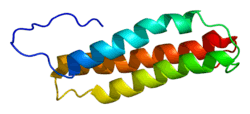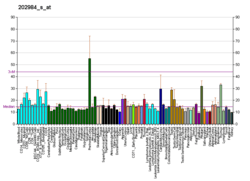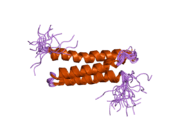BAG5
BAG family molecular chaperone regulator 5 is a protein that in humans is encoded by the BAG5 gene.[5][6][7]
The protein encoded by this gene is a member of the BAG1-related protein family. BAG1 is an anti-apoptotic protein that functions through interactions with a variety of cell apoptosis and growth related proteins including BCL-2, Raf-protein kinase, steroid hormone receptors, growth factor receptors and members of the heat shock protein 70 kDa family. This protein contains a BAG domain near the C-terminus, which could bind and inhibit the chaperone activity of Hsc70/Hsp70. Three transcript variants encoding two different isoforms have been found for this gene.[7]
References
- 1 2 3 GRCh38: Ensembl release 89: ENSG00000166170 - Ensembl, May 2017
- 1 2 3 GRCm38: Ensembl release 89: ENSMUSG00000049792 - Ensembl, May 2017
- ↑ "Human PubMed Reference:".
- ↑ "Mouse PubMed Reference:".
- ↑ Takayama S, Xie Z, Reed JC (Feb 1999). "An evolutionarily conserved family of Hsp70/Hsc70 molecular chaperone regulators". J Biol Chem. 274 (2): 781–6. doi:10.1074/jbc.274.2.781. PMID 9873016.
- ↑ Kalia SK, Lee S, Smith PD, Liu L, Crocker SJ, Thorarinsdottir TE, Glover JR, Fon EA, Park DS, Lozano AM (Dec 2004). "BAG5 inhibits parkin and enhances dopaminergic neuron degeneration". Neuron. 44 (6): 931–45. doi:10.1016/j.neuron.2004.11.026. PMID 15603737.
- 1 2 "Entrez Gene: BAG5 BCL2-associated athanogene 5".
External links
- Human BAG5 genome location and BAG5 gene details page in the UCSC Genome Browser.
Further reading
- Takayama S, Sato T, Krajewski S, et al. (1995). "Cloning and functional analysis of BAG-1: a novel Bcl-2-binding protein with anti-cell death activity". Cell. 80 (2): 279–84. doi:10.1016/0092-8674(95)90410-7. PMID 7834747.
- Maruyama K, Sugano S (1994). "Oligo-capping: a simple method to replace the cap structure of eukaryotic mRNAs with oligoribonucleotides". Gene. 138 (1–2): 171–4. doi:10.1016/0378-1119(94)90802-8. PMID 8125298.
- Höhfeld J, Jentsch S (1997). "GrpE-like regulation of the hsc70 chaperone by the anti-apoptotic protein BAG-1". EMBO J. 16 (20): 6209–16. doi:10.1093/emboj/16.20.6209. PMC 1326305. PMID 9321400.
- Suzuki Y, Yoshitomo-Nakagawa K, Maruyama K, et al. (1997). "Construction and characterization of a full length-enriched and a 5'-end-enriched cDNA library". Gene. 200 (1–2): 149–56. doi:10.1016/S0378-1119(97)00411-3. PMID 9373149.
- Nagase T, Ishikawa K, Suyama M, et al. (1999). "Prediction of the coding sequences of unidentified human genes. XII. The complete sequences of 100 new cDNA clones from brain which code for large proteins in vitro". DNA Res. 5 (6): 355–64. doi:10.1093/dnares/5.6.355. PMID 10048485.
- Strausberg RL, Feingold EA, Grouse LH, et al. (2003). "Generation and initial analysis of more than 15,000 full-length human and mouse cDNA sequences". Proc. Natl. Acad. Sci. U.S.A. 99 (26): 16899–903. doi:10.1073/pnas.242603899. PMC 139241. PMID 12477932.
- Ota T, Suzuki Y, Nishikawa T, et al. (2004). "Complete sequencing and characterization of 21,243 full-length human cDNAs". Nat. Genet. 36 (1): 40–5. doi:10.1038/ng1285. PMID 14702039.
- Gerhard DS, Wagner L, Feingold EA, et al. (2004). "The Status, Quality, and Expansion of the NIH Full-Length cDNA Project: The Mammalian Gene Collection (MGC)". Genome Res. 14 (10B): 2121–7. doi:10.1101/gr.2596504. PMC 528928. PMID 15489334.
This article is issued from
Wikipedia.
The text is licensed under Creative Commons - Attribution - Sharealike.
Additional terms may apply for the media files.








